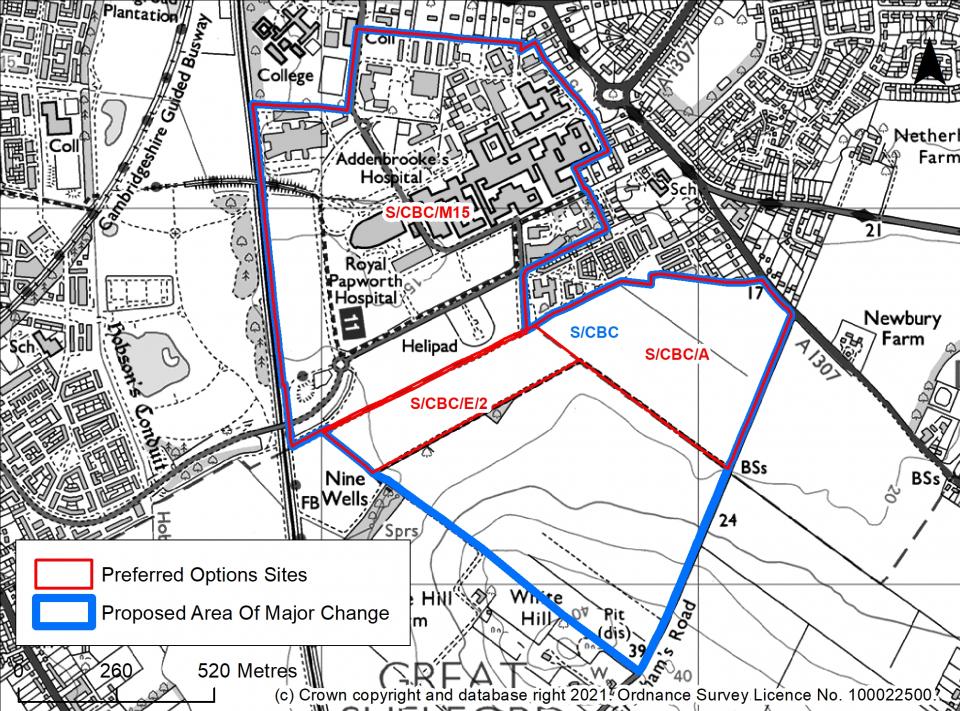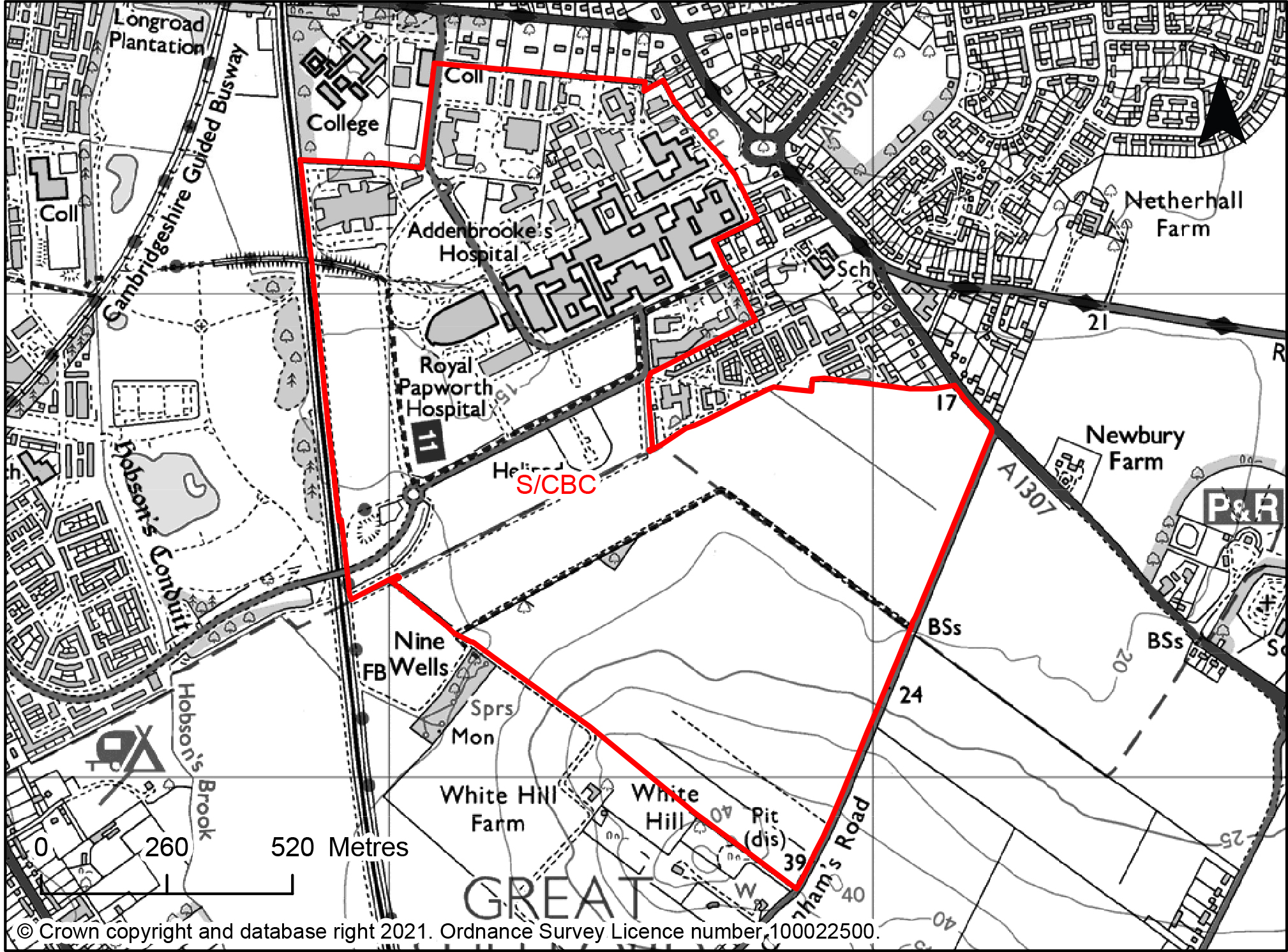
What will this policy do?
This policy will guide the continued development and evolution of the Cambridge Biomedical Campus.
Proposed policy direction
The will support development on the Cambridge Biomedical Campus to meet local, regional or national health care needs or for biomedical and biotechnology research and development activities, related higher education and sui generis medical research institutes, associated support activities to meet the needs of employees and visitors, and residential uses where it would provide affordable and key worker homes for campus employees.
An Area of Major Change
The area for development includes the main campus, (S/CBC/Policy M15 on the map) and the area previously allocated for its extension through the South Cambridgeshire 2018 (S/CBC/Policy E/2 on the map). An updated masterplan will be required for the Campus, to improve the overall experience of the site for workers and visitors. This should maximise opportunities to improve the ‘legibility’ of the Campus by providing a network of cycle and pedestrian routes, high quality new public realm and open space, but in particular explore opportunities to enhance connections with the proposed Cambridge South Railway Station.
An additional area adjoining Babraham Road (S/CBC-A on the map) is identified as a potential area to be released from the specifically to meet the long-term needs of the Campus. Any release would be subject to the following:
- Significant enhancement in adjoining areas of White Hill and Nine Wells will be required, to provide green infrastructure and biodiversity improvements supporting the objectives of the Strategic Initiative 3: Gog Magog Hills and chalkland fringe. These areas would remain within the and are included in the Area of Major Change to highlight that future proposals for built development on the allocated areas must also include green infrastructure and biodiversity improvements within its adjoining open area.
- A comprehensive landscaping plan, including the delivery of new publicly accessible green space will need to be delivered, to create a soft green edge of the city, to minimise the urbanising effects of the development and help compensate for harm to the .
- No development will be permitted south of Granham’s Road. However there may be potential to realign the eastern end of Granham’s Road to a point no further south than the southern boundary of the Wort’s Causeway development to the east of Babraham Road, subject to achieving an acceptable junction arrangement, with the boundary following the line of the road. The additional area that may be created by realigning Granham’s Road is shown as a separate area at this stage, and will be explored further, with the boundary to be defined in the draft .
- Design parameters regarding the scale and height of buildings will be established, to respond to the landscape and townscape of Cambridge.
- is dependent on the successful implementation of a Trip Budget approach, to ensure that the level of vehicle trips is limited to an appropriate level for the surrounding road network.
- on the additional land will only be allowed to take place when evidence is provided that opportunities on the existing campus have been fully explored and utilised before development takes place on the released land.
- Given the existing piecemeal development on the biomedical campus, any proposed release must contribute towards improving the wellbeing of campus users and surrounding communities, as well as addressing the spill over impacts on individuals and communities of this intensive employment location.
Errata: The third bullet in the Proposed Policy Direction for Cambridge Biomedical Campus (Policy S/CBC) is an error and does not reflect the wording agreed by the Councils for consultation
We therefore propose to address the Biomedical Campus area via the following existing and new sites:
New allocations
Sites for the potential future expansion of the Campus through this First Proposals Plan:
- S/CBC-A - Possible future expansion area adjoining Babraham Road (pdf)
Continuing existing allocations
- S/CBC/Policy M15: Cambridge Biomedical Campus (including Addenbrooke’s Hospital) - The main campus (Cambridge 2018) (pdf)
- S/CBC/Policy E/2: Cambridge Biomedical Campus Extension: Existing committed expansion (South Cambridgeshire 2018) (pdf)
Continuing and expanding an existing Area of Major Change
Policy 17: Cambridge Biomedical Campus (including Addenbrooke’s Hospital) Area of Major Change: An expanded Area of Major Change, incorporating:
- The areas covered by the allocations as above, as well as
- Area of green infrastructure and biodiversity improvements to the south west of any future expansion area’s built development boundary

Why is this policy needed?
The Cambridge Biomedical Campus is of national and international importance. It has a local, regional and national role in providing medical facilities and medical research. It is a key location for the life-sciences and biotechnology cluster of . Previous Local Plans have responded to the 2020 vision for the campus, enabling it to evolve into its current role. Significant investment in infrastructure is now planned, with funding committed for a new Cambridge South Railway Station.
The Cambridge Biomedical Campus have now prepared a 2050 Vision, setting out aspirations for its future. This includes continuing development on the existing campus site, and an aspiration for further development. Proposals have been submitted on large areas of land south of the campus and between the M11, Addenbrookes Road and the A1301.
National planning policy is clear that once established, boundaries should only be altered in exceptional circumstances, where this is fully evidenced and justified, through the preparation or updating of plans. Given the national importance of the Campus in health, life-sciences and biotechnology, and the significant public investment into the area with the new Cambridge South Railway Station, it is considered that it may be possible to demonstrate a case for exceptional circumstances to release land from the in this location, but this needs to be balanced with the existing supply of employment land in the area, and the impacts on the environment and how they can be mitigated.
In considering the impact on the it is important to consider the nature and extent of the harm to purposes. The Study (2021) identifies that release of the areas proposed would result in very high harm to the . In addition, there are concerns regarding biodiversity and landscape impacts of the scale of development proposed by the Campus.
However, the Study identifies an area adjoining Babraham Road and north of Granham's Road where the harm of release would be lower than other land in this area, although this is still acknowledged as a high level of harm. There is potential to focus development on a smaller area of land to support the Campus (S/CBC-A on the map), that contains development on the lower land away from White Hill and provides an opportunity to create a new comprehensive green edge to the city.
It will be crucial that impacts are minimised by effective landscaping and the enhancement of green infrastructure south of the existing campus. National Planning policy requires that the impact of removing land from the to be offset through compensatory improvements to the environmental quality and accessibility of remaining land. There are opportunities immediately south of the campus and west of the potential release, in the areas of Nine Wells and White Hill (the area bounded by the blue line of the Proposed Area of Major Change on the map). This should include providing areas where public access is enhanced, but it must also include improvements to areas where public access is restricted, which can help secure biodiversity net gain, providing connections between Nine Wells and the Gog Magog Hills. at the Campus is at the fringes of the Strategic Initiative 3: Gog Magog Hills and chalkland fringe (see BG/GI: ).
The high water table and surface water flooding present challenges to development in this area. A comprehensive approach would be required to deliver sustainable drainage systems, which ensure the development is safe, and does not increase risk elsewhere.
If the identified land is to be released for development it is important that the best use is made of the existing campus site first. Whilst there are some fantastic buildings and areas on the site, there are other areas which are underused, and do not provide a good environment for visitors and workers. It is proposed that the policy in the new seek a comprehensive approach to the site through a new masterplan.
The opportunities provided by the new Cambridge South Station to enhance public transport access to the Campus need to be maximised. An updated transport strategy for the site will be required. The outstanding public transport and active travel access available to the site mean that car access and parking should be reserved for those who need it most. A ‘trip budget’ approach needs to be applied, requiring a very high level of travel to the site by non-car modes.
What consultation have we done on this issue?
There was no specific consultation on this issue in the First Conversation consultation.
What alternatives did we consider?
1. No release of or additional allocation outside the existing Campus. – This alternative is not the preferred approach, as it would not respond to the needs of the campus.
2. A larger land release reflecting the proposal (referred to as Cambridge South) by a group of landowners with the support of the Cambridge Biomedical Campus – This alternative is not the preferred approach, due to the level of harm to , landscape and biodiversity.
Supporting evidence studies and topic papers
- : Topic paper 1: Strategy
- Housing and Employment Land Availability Assessment (2021)
Existing policies in adopted 2018 Local Plans
Cambridge 2018
- Policy 14: Areas of Major Change and – general principles
- Policy 17: Cambridge Biomedical Campus (including Addenbrooke’s Hospital) Area of Major Change
- M15: Cambridge Biomedical Campus (including Addenbrooke’s Hospital)
South Cambridgeshire 2018
- Policy E/2: Cambridge Biomedical Campus Extension
Tell us what you think
Our consultation for this phase is now closed.